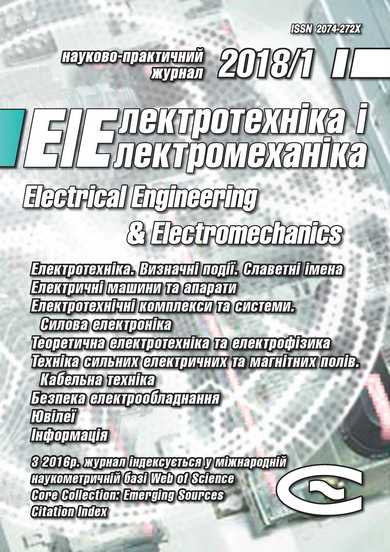COMPARATIVE ANALYSIS OF ELECTRICAL AND THERMAL CONTROL OF THE LINING STATE OF INDUCTION APPARATUS OF COPPER WIRE MANUFACTURE
DOI:
https://doi.org/10.20998/2074-272X.2018.1.05Keywords:
induction heating, diagnostics and control, interconnected electromagnetic and thermal processes, thermal field distribution, three-dimensional mathematical modeling, finite element methodAbstract
Aim. This article is intended to develop a technique for monitoring the lining state of induction channel furnaces for melting oxygen-free copper by monitoring changes in the distribution of thermal fields in their lining and carrying out a comparative analysis of the developed technique with the existing one that controls the electrical resistance of the melting channel of the furnaces. Technique. For carrying out the research, the theories of electromagnetic field, thermodynamics, mathematical physics, mathematical modeling based on the finite element method were used. Results. A technique for diagnosing the lining state of the induction channel furnaces for melting oxygen-free copper has been developed, which makes it possible to determine the dislocation and the size of the liquid metal leaks by analyzing the temperature distribution over the body surface both the inductor and the furnace. Scientific novelty. The connection between the temperature field distribution on the surface of the furnace body and the dislocation and dimensions of the liquid metal leaks in its lining is determined for the first time. Practical significance. Using the proposed technique will allow to conduct more accurate diagnostics of the lining conditions of the induction channel furnaces, as well as to determine the location and size of the liquid metal leaks, creating the basis for predicting the working life of the furnaceReferences
1. .Bermúdez A., Gómez D., Muñiz M.C., Salgado P., Vázquez R. Numerical simulation of a thermo-electromagneto-hydrodynamic problem in an induction heating furnace. Applied Numerical Mathematics, 2009, vol.59, no.9, pp. 2082-2104. doi: 10.1016/j.apnum.2008.12.005.
2. Gleim T., Schröder B., Kuhl D. Nonlinear thermo-electromagnetic analysis of inductive heating processes. Archive of Applied Mechanics, 2015, vol.85, no.8, pp. 1055-1073. doi: 10.1007/s00419-014-0968-1.
3. Lucia O., Maussion P., Dede E.J., Burdio J.M. Induction heating technology and its applications: past developments, current technology, and future challenges. IEEE Transactions on Industrial Electronics, 2014, vol.61, no.5, pp. 2509-2520. doi: 10.1109/TIE.2013.2281162.
4. Pepper D.W., Heinrich J.C. The Finite Element Method: Basic Concepts and Applications with MATLAB, MAPLE, and COMSOL. CRC Press, 2017. 610 p.
5. Stegmueller M.J.R., Schindele P., Grant R.J. Inductive heating effects on friction surfacing of stainless steel onto an aluminum substrate. Journal of Materials Processing Technology, 2015, vol.216, pp. 430-439. doi: 10.1016/j.jmatprotec.2014.10.013.
6. UPCAST, Finland. Available at: http://www.upcast.com (accessed 10 May 2017).
7. Hadad Y., Kochavi E., Levy A. Inductive heating with a stepped diameter crucible. Applied Thermal Engineering, 2016, vol.102, pp. 149-157. doi: 10.1016/j.applthermaleng.2016.03.151.
8. Zolotaryov V.M., Belyanin R.V., Podoltsev O.D. Analysis of electromagnetic processes in the induction channel furnace used in the cable industry. Works of the Institute of Electrodynamics of the National Academy of Sciences of Ukraine, 2016, vol.44, pp. 110-115. (Rus).
9. Shcherba A.A., Podoltsev O.D., Kucheriava I.M., Ushakov V.I. Computer modeling of electrothermal processes and thermo-mechanical stress at induction heating of moving copper ingots. Technical Electrodynamics, 2013, no.2, pp. 10-18. (Rus).
10. Zolotaryov V.M., Shcherba M.A., Belyanin R.V. Three-dimensional modeling of electromagnetic and thermal processes of induction melting of copper template with accounting of installation elements design. Technical Electrodynamics, 2017, no.3, pp. 13-21. (Rus).
Downloads
Published
How to Cite
Issue
Section
License
Copyright (c) 2018 V. M. Zolotaryov, M. A. Shcherba, R. V. Belyanin, R. P. Mygushchenko, O. Yu. Kropachek

This work is licensed under a Creative Commons Attribution-NonCommercial 4.0 International License.
Authors who publish with this journal agree to the following terms:
1. Authors retain copyright and grant the journal right of first publication with the work simultaneously licensed under a Creative Commons Attribution License that allows others to share the work with an acknowledgement of the work's authorship and initial publication in this journal.
2. Authors are able to enter into separate, additional contractual arrangements for the non-exclusive distribution of the journal's published version of the work (e.g., post it to an institutional repository or publish it in a book), with an acknowledgement of its initial publication in this journal.
3. Authors are permitted and encouraged to post their work online (e.g., in institutional repositories or on their website) prior to and during the submission process, as it can lead to productive exchanges, as well as earlier and greater citation of published work.





